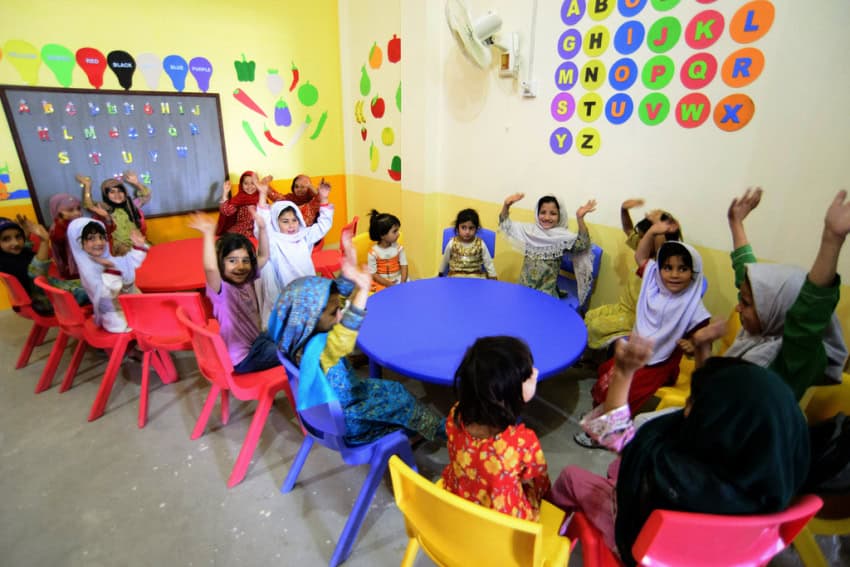Failure of successive governments to provide quality primary and secondary education over the last few decades has resulted in private sector picking up the mantle and filling the gap for providing quality education. Over the years as the number of private schools increased, government schools further became complacent, although teachers, ghost or otherwise, continued to draw much higher salaries than what is paid to teachers in the private sector.
As private schools gained traction, for-profit schools became a norm, and in absence of any regulation, the tuition fee set by such schools became arbitrary and exploitative. It is estimated that the median tuition fee, including various incidentals, for a private school in Karachi is PKR 14,000 per month, making up a high proportion of any household’s monthly budget.
Advocates of private schools suggest that such levels of tuition fee are a function of demand and supply. The inability of the government to provide quality education has led to a massive supply gap for education, enabling the private schools to charge a pound of flesh as monthly tuition fee. They also advocate that parents are free to not send their children to schools whose fee they can’t afford – not realizing that education remains a fundamental right of every child in the country.
Such laissez-faire approach of private schools and its advocates has created a natural oligopoly, where a fee base is fixed by certain schools with branches all over the country – with fee increments often double or triple of average inflation (as measured by the Consumer Price Index) in the country. A free market approach which is often advocated by private schools to set monthly tuition fee is not valid as a free market for education can simply not exist.
In a free market, the private schools would be suppliers, while children (or their parents) would provide the demand. A basic fundamental premise of perfect competition in a free market is that a buyer should be able to choose from suppliers, without any barriers to entry or exit. If a price increases due to a decrease in supply or any other reason, the buyer is free to substitute with another good, and so on. For example, if the price of bread is increased by a supplier, a buyer can simply switch to another bread supplier, or substitute with some other form of bread – in this way the demand would decrease, and the price would fall to its natural equilibrium point.
Such a free market is not possible in the case of private schools, as buyers (students or parents) get into a long-term contract with a school (for education), and thereby cannot simply move to another school because the tuition fee is jacked up arbitrarily.
Similarly, Admission Fee charged by schools, which is often in multiples of as high as ten times of monthly fee, is a significant barrier to entry or exit, as substitution of schools becomes a more cost-intensive proposition. Such a lopsided structure warrants existence of an oligopoly where the supplier (private school) has more bargaining power than the buyer (students or parents), with significant barriers of entry and exit imposed on the buyer (student or parents). An oligopolistic market structure largely serves interests of suppliers given their ability to set exploitative prices amidst lower bargaining power of buyers.
Even on the supply side, workers (or teachers) are grossly underpaid, despite existence of relevant regulation (which is never implemented) in Sindh through Sindh Private Educational Institutions (Regulation and Control) Ordinance, 2001, Article 10(1) of which states that “minimum salary and allowances of a full-time teacher with twelve months of continuous service shall not be less than four times the monthly fee of the single student in the highest class charged by the institution.”The author could not find a single private school which was following the regulation in letter, or spirit. Teachers in private schools are grossly underpaid compared to their peers in the public sector, often earning below minimum wage. Despite setting a high base rate for a monthly fee, human capital (which forms the core) in private schools remains underpaid.
Considering how a free market for education can simply not exist and how access to education is a fundamental right – it is essential that the private education ‘industry’ in the country is regulated as a utility. If a free market (as envisaged by private schools) is allowed to prevail for a utility like electricity, households would be at the mercy of the power generation and electricity distribution companies – who would be able to charge an arbitrary price, which may be exploitative in nature. Although electricity cost in Pakistan still remains higher than peers, it remains stringently regulated. In absence of regulation, access would remain a function of wealth (resulting in further income inequalities), rather than a fundamental need.
Through regulation as utility, cost inputs of private schools, such as salaries of teachers, salaries of support staff, utility bills, rents, etc. can be assessed in a transparent manner. Such a process would also ensure that human capital employed by the schools is not underpaid, and continues to get a fair wage. Once assessment of cost inputs is in place, a profit margin can also be ascertained, such that it is also embedded in the tuition fee.
Once all cost inputs and profit margin have been accounted for, the tuition fee can be ascertained for a period of 2-3 years, such that there is consistency in fee levels. All cost inputs may also be indexed to relevant inflation index, such that the growth in cost inputs remains in-line with overall inflation – resulting in a corresponding change in monthly fee levels.
Regulation of private schools as a utility may not only lead to transparency in how monthly tuition fee is determined, but will also ensure that teachers are fairly paid, and are not exploited by an oligopolistic paymaster. Currently existing free market approach towards the determination of tuition fee effectively discriminates on the basis of wealth, as it implicitly suggests that quality education remains a function of wealth, further sowing the seeds for income inequality, and wealth concentration. An oligopolistic structure of private schools destroys consumer welfare, while encouraging profiteering practices.
It is time that the Government starts regulating private schools as a utility, and discourages an exploitative pricing regime in the provision of the fundamental right of access to education.














